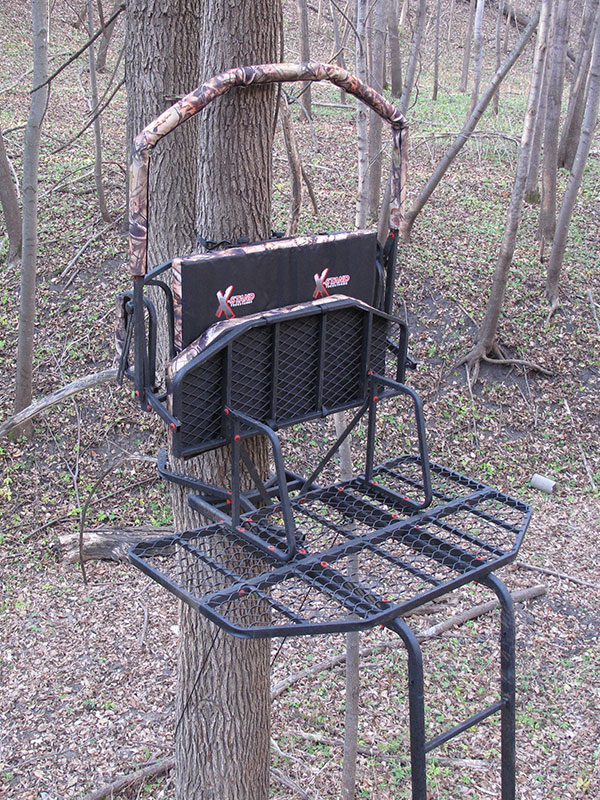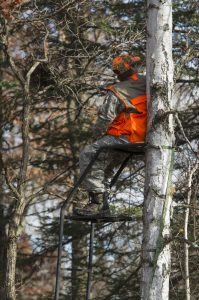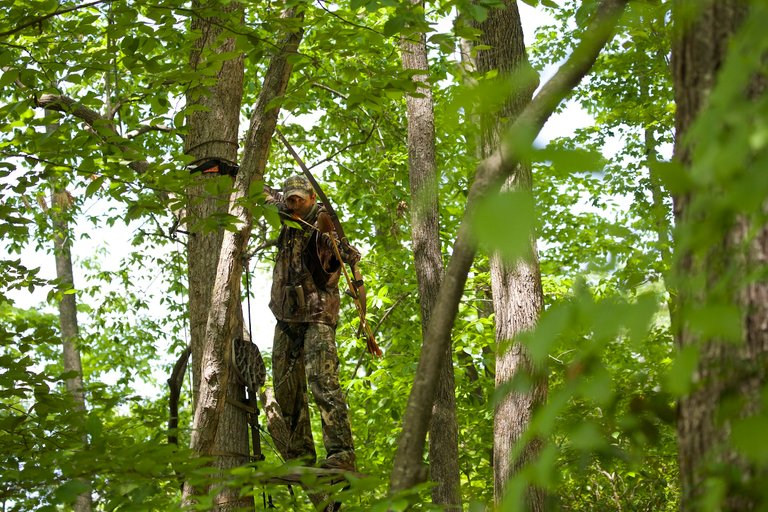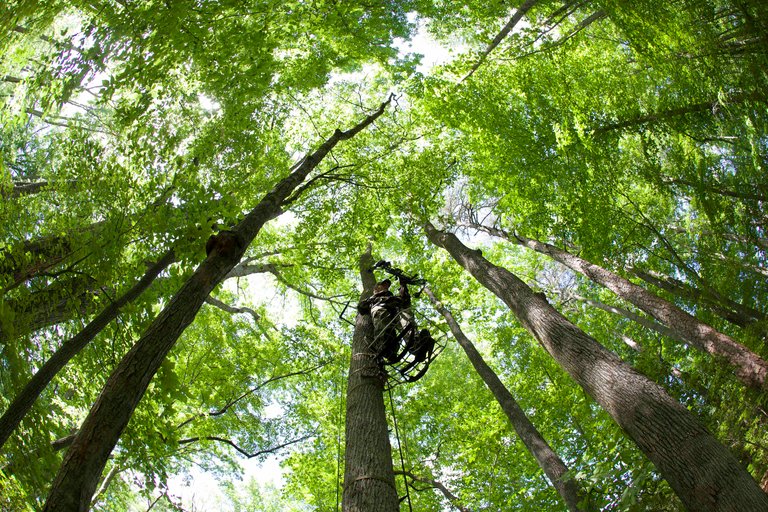Common-Sense Tree Stand Placement Isn’t So Common

One of my favorite pastimes is bowhunting with my family in northeast Oklahoma, a hop, skip and six-hour drive north. My trip up began at the break of dawn, and I pulled into a restaurant to have lunch with a family friend, Dirk, before heading out to his honey hole. I had heard several stories from family members about Dirk’s special spot, so the chance to finally hunt with him had me smiling from ear to ear.
30 Miles to a "No Hunting" Sign?
After lunch, we drove roughly 30 miles west to the property and came to a stop next to a rough-looking gate with a worse-for-wear sign reading, “No Hunting." Dirk was quick to point out, “That doesn’t apply to us.” I laughed quietly as we slowly opened the truck doors and slid out. At the back of the truck, we gathered our gear and doused ourselves in a scent elimination spray. As we prepared to leave, I reached for my safety harness but Dirk stopped me. “You’re not going to need that.”
His instruction caught me a bit off guard. “We’re hunting from a tree stand, right?”
He nearly cut me off and repeated, “Yes, but you’re not going to need that. Trust me.”
I responded again, “I won’t hunt from a tree stand without a harness, man.”
Dirk smiled. “Suit yourself. Let’s go.”

I fell in behind Dirk. He was still smiling as we headed down an overgrown trail. A quarter mile later, we came to a bowl—it looked like a perfect place to hunt. As we walked into the area, I quickly spotted two tree stands perched 15 feet or so up on a couple trees growing side by side. I was glad I brought my harness…at least until we walked right past those tree stands and kept on moving down the trail. A couple hundred yards past the bowl, we reached a creek bottlenecked by a stout beaver dam. Using the dam as a bridge, we carefully crossed the creek and climbed a steep bank. The top of the bank opened up to a narrow clearing just 40 yards wide.
The left side of the hill was lined by a slope that emptied into the clearing while the right side was lined with mature cedar trees—I love the smell of cedar, and in an environment like that, you would be hard-pressed to find a better cover scent.
Just Trust Me!
I followed Dirk to the right side of a narrow field. He walked past the first couple of cedar trees, stopped at the third, turned to smile at me again, and then headed into the cedar’s thick branches. Admittedly a bit confused at the lack of tree stands or taller trees from which to hang them, I followed him into the cedar’s enveloping cover. Just a couple feet in front of me was the tree stand he promised, not more than 2 feet off the ground. To say I was surprised was an understatement. I literally turned around and looked in all directions for some hidden camera—“This is a joke right?”
“Quiet down," he said. "Get up in the seat.”
While a single ladder extension was tethered to the tree, I didn’t need it. A limb just a foot off the ground was a natural step. I took one step onto the limb, another onto the platform, turned around and sat down. I was close enough to the ground, in fact, that I literally took my backpack off and set it on the ground next to the tree stand floor. When I finally got settled and looked to my front, I was shocked! Dirk had used a couple ratchet straps attached to limbs on either side of the tree stand to pull the branches apart. The result was a natural window…and I quite literally hidden in the tree with Dirk sitting next to me on an off-set stand attached to the same trunk.
I thought I had seen and done just about everything when it came to deer hunting. I was wrong; in fact, not only was I wrong, I was humbled a bit.
As an outdoor writer with bowhunting successes that included spot-and-stalk pursuits, still hunts from ground blinds, night hunting and more, I thought I had seen and done just about everything when it came to deer hunting. I was wrong; in fact, not only was I wrong, I was humbled a bit. I should have trusted Dirk, and indeed, the moment emphasized that I am never done learning. The takeaway here? Tree stands can be ideal tools for hunting; however, their use and placements should be dictated by the environment. This takes some common sense—my wife would suggest that for me, that means thinking outside the box.
Create Your Own Luck
Honestly, while we envision hunting environments and how we expect hunts to go down, they rarely play out that way. An old quote that some credit to Seneca, the ancient Roman philosopher, suggests, “Luck is what happens when preparation meets opportunity.” I tend to agree—we create our own “luck” by employing those common-sense strategies, tree stand placements being a great example. In an outdoorsman world where we are somehow indoctrinated, for lack of a better term, to believe tree stands must be hung 10, 15, 20 or even 30 feet in the air, who among people reading this would ever have considered hanging a stand just 2 feet off the ground? Walking into that open area on Dirk's property, lined with full yet squatty cedars, I never would have considered anything other than ground blinds, natural or otherwise.
Do you hang or erect a tree stand based on sunlight, shade or prevailing wind direction?
Consider how and where you hang tree stands, or where you hunt for that matter. Do you avoid areas lacking tall, straight trees? Have you ever considered that a tree stand doesn’t need to tower over the ground? Stand height aside, do you hang or erect a tree stand based on sunlight, shade or prevailing wind direction? The overarching lesson here, with respect to tree stands, is that their use can be as versatile as the environments in which we use them. Since my own realization tree stands don’t necessarily need to be 20 feet up, I’ve even used lock-on stands more than once on trees for duck hunting—I install the stand just above the water line on a tree trunk and get comfortable.
Consider these tips when determining where and how to hang your tree stands:
- Traditional placements have a tree stand placed as high as comfortable—at the base of the tree’s canopy is best.
- Don’t be afraid to hang a tree stand at a lower elevation. I learned a tree stand mounted just 2 feet off the ground in a cedar was perfect. That day, I arrowed the largest doe of my life at 23 yards.
- Do your best, even in a tree stand, to mask your position—choosing foliage, a cedar or under the base of a canopy are all great strategies.
- Consider hanging a tree stand in a predominantly shaded area. Shade can cloak movement exceptionally well.
- Hang stands downwind (based on prevailing wind direction) and near trails, intersections, water supplies and feeding areas.
- Tree stands can be difficult and even dangerous to install. Get help! Never hang a tree stand on your own. Even installing stands 2 feet off the ground can be troublesome.
- Check your stands and straps often, and make necessary changes and adjustments.


